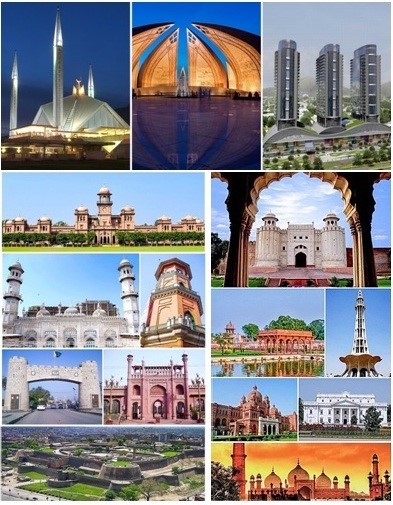Peshawar is the capital of the Pakistani province of Khyber Pakhtunkhwa. It is located in the broad Valley of Peshawar near the eastern end of the historic Khyber Pass, close to the border with Afghanistan. Peshawar’s recorded history dates back to at least 539 BCE, making it the oldest city in Pakistan and one of the oldest cities in the world. Peshawar was the capital of the ancient Kushan Empire, and was home to what may have been the tallest building in the ancient world, the Kanishka stupa. Peshawar was then sacked by the White Huns, before the arrival of Muslim empires. The city was an important trading centre during the Mughal era before serving as the winter capital of the Afghan Durrani Empire from 1757 until the city was captured by the Sikhs in 1818, who were then followed by the British in 1849.
The city of Peshawar has a population of 1,970,042 according to the 2017 census, making it the largest city in Khyber Pakhtunkhwa and the sixth-largest in Pakistan, while Peshawar District has a population of 4,269,079.
Lahore is a city in the Pakistan, in the province of Punjab. Lahore is the country’s second-most populous city after Karachi and is one of Pakistan’s wealthiest cities with an estimated GDP of $58.14 billion (PPP) as of 2015. Lahore is the largest city, and historic cultural centre of the Punjab region, and one of Pakistan’s most socially liberal, progressive, and cosmopolitan cities.
Lahore’s origins reach into antiquity. The city has been controlled by numerous empires throughout the course of its history, including the Hindu Shahis, Ghaznavids, Ghurids, and Delhi Sultanate by the medieval era. Lahore reached the height of its splendor under the Mughal Empire between the late 16th and early 18th century, and served as its capital city for a number of years. The city was captured by the forces of the Afsharid ruler Nader Shah in 1739, and fell into a period of decay while being contested between the Afghans and the Sikhs. Lahore eventually became capital of the Sikh Empire in the early 19th century, and regained much of its lost grandeur. Lahore was then annexed to the British Empire, and made capital of British Punjab. Lahore was central to the independence movements of both India and Pakistan, with the city being the site of both the declaration of Indian Independence, and the resolution calling for the establishment of Pakistan. Lahore experienced some of the worst rioting during the Partition period preceding Pakistan’s independence. Following independence in 1947, Lahore was declared capital of Pakistan’s Punjab province.
The city of Lahore exerts a strong cultural influence over Pakistan, and is a major centre for Pakistan’s publishing industry, and remains the foremost centre of Pakistan’s literary scene. The city is also a major centre of education in Pakistan, with some of Pakistan’s leading universities based in the city. Lahore is also home to Pakistan’s film industry, Lollywood, and is a major centre of Qawwali music. The city also hosts much of Pakistan’s tourist industry, with major attractions including the Walled City, the famous Badshahi and Wazir Khan mosques and Sikh shrines. Lahore is also home to the Lahore Fort and Shalimar Gardens, both of which are UNESCO World Heritage Sites.
Karachi is the capital of the Pakistani province Sindh. It is the most populous city in Pakistan, and sixth-most-populous city proper in the world. Ranked as a beta world city, the city is Pakistan’s premier industrial and financial centre and is considered as the cultural, economic, philanthropic, educational, and political hub of the country. Karachi is also Pakistan’s most cosmopolitan city. Situated on the Arabian Sea, Karachi serves as a transport hub, and is home to Pakistan’s two largest seaports, the Port of Karachi and Port Bin Qasim, as well as the Pakistan’s busiest airport, Jinnah International Airport.
Though the Karachi region has been inhabited for millennia, the city was founded as the fortified village of Kolachi in 1729. The settlement drastically increased in importance with the arrival of British East India Company in the mid-19th century, who not only embarked on major works to transform the city into a major seaport, but also connected it with their extensive railway network. By the time of the Partition of British India, the city was the largest in Sindh with an estimated population of 400,000. Following the independence of Pakistan, the city’s population increased dramatically with the arrival of millions of Muslim refugees from India. The city experienced rapid economic growth following independence, attracting migrants from throughout Pakistan and South Asia.
Karachi is one of Pakistan’s most secular and socially liberal cities. It is also the most linguistically, ethnically, and religiously diverse city in Pakistan Karachi’s population was enumerated at 14.9 million in the 2017 census, though the figure was immediately disputed by various factions as a severe underestimate, with some sources estimating a population of up to 30 million. Karachi is one of the world’s fastest growing cities, and has communities representing almost every ethnic group in Pakistan. Karachi is home to over 2 million Bangladeshi immigrants, 1 million Afghan refugees, and up to 400,000 Rohingyas from Myanmar. Karachi is now Pakistan’s premier industrial and financial centre. The city has a formal economy estimated to be worth $113 billion as of 2014 which is the largest in Pakistan. Karachi collects over a third of Pakistan’s tax revenue and generates approximately 20% of Pakistan’s GDP. Approximately 30% of Pakistani industrial output is from Karachi, while Karachi’s ports handle approximately 95% of Pakistan’s foreign trade Approximately 90% of the multinational corporations operating in Pakistan are headquartered in Karachi, Karachi is considered to be Pakistan’s fashion capital, and has hosted the annual Karachi Fashion Week since 2009.

